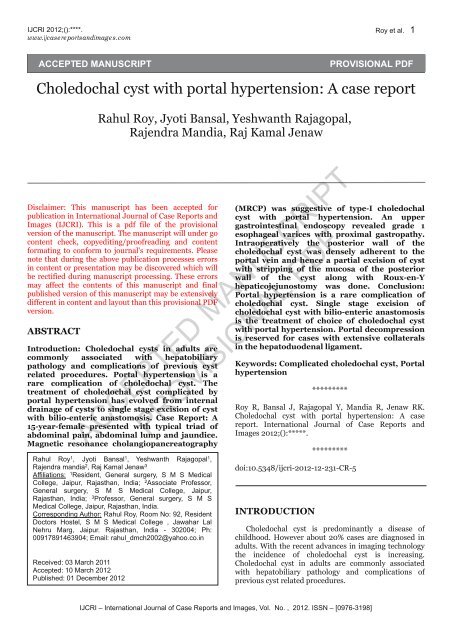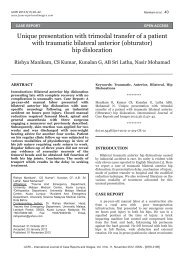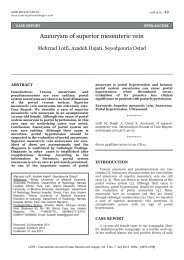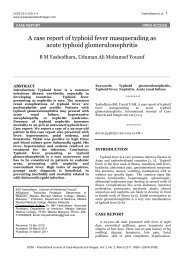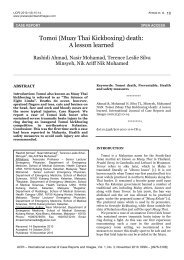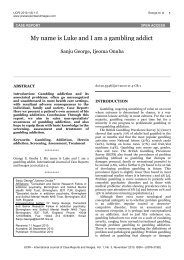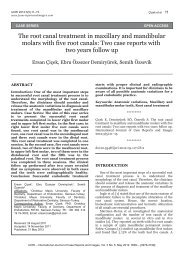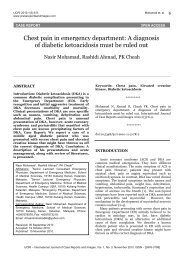Provisional PDF - International Journal of Case Reports and Images ...
Provisional PDF - International Journal of Case Reports and Images ...
Provisional PDF - International Journal of Case Reports and Images ...
You also want an ePaper? Increase the reach of your titles
YUMPU automatically turns print PDFs into web optimized ePapers that Google loves.
IJCRI 201 2;():****.<br />
www.ijcasereports<strong>and</strong>images.com<br />
Roy et al. 1<br />
ACCEPTED CASE SERIESMANUSCRIPT<br />
PROVISIONAL OPEN ACCESS <strong>PDF</strong><br />
Choledochal cyst with portal hypertension: A case report<br />
Rahul Roy, Jyoti Bansal, Yeshwanth Rajagopal,<br />
Rajendra M<strong>and</strong>ia, Raj Kamal Jenaw<br />
Disclaimer: This manuscript has been accepted for<br />
publication in <strong>International</strong> <strong>Journal</strong> <strong>of</strong> <strong>Case</strong> <strong>Reports</strong> <strong>and</strong><br />
<strong>Images</strong> (IJCRI). This is a pdf file <strong>of</strong> the provisional<br />
version <strong>of</strong> the manuscript. The manuscript will under go<br />
content check, copyediting/pro<strong>of</strong>reading <strong>and</strong> content<br />
formating to conform to journal's requirements. Please<br />
note that during the above publication processes errors<br />
in content or presentation may be discovered which will<br />
be rectified during manuscript processing. These errors<br />
may affect the contents <strong>of</strong> this manuscript <strong>and</strong> final<br />
published version <strong>of</strong> this manuscript may be extensively<br />
different in content <strong>and</strong> layout than this provisional <strong>PDF</strong><br />
version.<br />
ABSTRACT<br />
Introduction: Choledochal cysts in adults are<br />
commonly associated with hepatobiliary<br />
pathology <strong>and</strong> complications <strong>of</strong> previous cyst<br />
related procedures. Portal hypertension is a<br />
rare complication <strong>of</strong> choledochal cyst. The<br />
treatment <strong>of</strong> choledochal cyst complicated by<br />
portal hypertension has evolved from internal<br />
drainage <strong>of</strong> cysts to single stage excision <strong>of</strong> cyst<br />
with bilioenteric anastomosis. <strong>Case</strong> Report: A<br />
15yearfemale presented with typical triad <strong>of</strong><br />
abdominal pain, abdominal lump <strong>and</strong> jaundice.<br />
Magnetic resonance cholangiopancreatography<br />
Rahul Roy 1 , Jyoti Bansal 1 , Yeshwanth Rajagopal 1 ,<br />
Rajendra m<strong>and</strong>ia 2 , Raj Kamal Jenaw 3<br />
Affiliations: 1<br />
Resident, General surgery, S M S Medical<br />
College, Jaipur, Rajasthan, India; 2<br />
Associate Pr<strong>of</strong>essor,<br />
General surgery, S M S Medical College, Jaipur,<br />
Rajasthan, India; 3<br />
Pr<strong>of</strong>essor, General surgery, S M S<br />
Medical College, Jaipur, Rajasthan, India.<br />
Corresponding Author: Rahul Roy, Room No: 92, Resident<br />
Doctors Hostel, S M S Medical College , Jawahar Lal<br />
Nehru Marg, Jaipur. Rajasthan, India - 302004; Ph:<br />
0091 7891 463904; Email: rahul_dmch2002@yahoo.co.in<br />
Received: 03 March 2011<br />
Accepted: 1 0 March 201 2<br />
Published: 01 December 201 2<br />
(MRCP) was suggestive <strong>of</strong> typeI choledochal<br />
cyst with portal hypertension. An upper<br />
gastrointestinal endoscopy revealed grade 1<br />
esophageal varices with proximal gastropathy.<br />
Intraoperatively the posterior wall <strong>of</strong> the<br />
choledochal cyst was densely adherent to the<br />
portal vein <strong>and</strong> hence a partial excision <strong>of</strong> cyst<br />
with stripping <strong>of</strong> the mucosa <strong>of</strong> the posterior<br />
wall <strong>of</strong> the cyst along with RouxenY<br />
hepaticojejunostomy was done. Conclusion:<br />
Portal hypertension is a rare complication <strong>of</strong><br />
choledochal cyst. Single stage excision <strong>of</strong><br />
choledochal cyst with bilioenteric anastomosis<br />
is the treatment <strong>of</strong> choice <strong>of</strong> choledochal cyst<br />
with portal hypertension. Portal decompression<br />
is reserved for cases with extensive collaterals<br />
in the hepatoduodenal ligament.<br />
Keywords: Complicated choledochal cyst, Portal<br />
hypertension<br />
*********<br />
Roy R, Bansal J, Rajagopal Y, M<strong>and</strong>ia R, Jenaw RK.<br />
Choledochal cyst with portal hypertension: A case<br />
report. <strong>International</strong> <strong>Journal</strong> <strong>of</strong> <strong>Case</strong> <strong>Reports</strong> <strong>and</strong><br />
<strong>Images</strong> 2012;():*****.<br />
ACCEPTED MANUSCRIPT<br />
PROVISIONAL <strong>PDF</strong><br />
*********<br />
doi:10.5348/ijcri201212231CR5<br />
INTRODUCTION<br />
Choledochal cyst is predominantly a disease <strong>of</strong><br />
childhood. However about 20% cases are diagnosed in<br />
adults. With the recent advances in imaging technology<br />
the incidence <strong>of</strong> choledochal cyst is increasing.<br />
Choledochal cyst in adults are commonly associated<br />
with hepatobiliary pathology <strong>and</strong> complications <strong>of</strong><br />
previous cyst related procedures.<br />
IJCRI – <strong>International</strong> <strong>Journal</strong> <strong>of</strong> <strong>Case</strong> <strong>Reports</strong> <strong>and</strong> <strong>Images</strong>, Vol. No. , 201 2. ISSN – [0976-31 98]
IJCRI 201 2;():****.<br />
www.ijcasereports<strong>and</strong>images.com<br />
Roy et al. 2<br />
Portal hypertension is a rare complication <strong>of</strong><br />
choledochal cyst. The treatment <strong>of</strong> choledochal cyst<br />
complicated by portal hypertension has evolved from<br />
internal drainage <strong>of</strong> cyst to single stage excision <strong>of</strong> cyst<br />
with bilioenteric anastomosis. Portal decompression is<br />
reserved for cases with extensive collaterals in the<br />
hepatoduodenal ligament. Here we report a case <strong>of</strong><br />
choledochal cyst with portal hypertension.<br />
CASE REPORT<br />
A 15yearold young female presented with typical<br />
traid <strong>of</strong> abdominal pain <strong>and</strong> abdominal lump for one<br />
year <strong>and</strong> jaundice for eight months. For last two months<br />
she also had pruritus with passage <strong>of</strong> clay colored stools.<br />
There was no previous history <strong>of</strong> acute cholecystitis,<br />
pancreatitis, hematemesis or melena. On biochemical<br />
investigations hemoglobin was 8.3 g/dl, serum bilirubin<br />
6.3 mg/dl, serum SGOT 258U/L, serum SGPT 105 U/L,<br />
serum alkaline phosphatase 711 IU/L <strong>and</strong> albuminglobulin<br />
ratio was 1:1.2. Viral markers for hepatitis B<br />
<strong>and</strong> C were negative. Abdominal ultrasonography<br />
showed a large cystic lesion <strong>of</strong> size 11.5x13 cm in<br />
epigastric region, hepatosplenomegaly with<br />
heterogenous coarse echotexture <strong>of</strong> liver, dilated<br />
Figure 1: Magnetic Resonance Cholangiopancreatography<br />
(MRCP) suggestive <strong>of</strong> choledochal cyst <strong>and</strong> dilated intrahepatic<br />
biliary radicle.<br />
intrahepatic biliary radicle (IHBR) <strong>and</strong> common bile<br />
duct (CBD). Proximal CBD measured 2.2 cm with nonvisualization<br />
<strong>of</strong> distal portion.<br />
On further investigating the patient, MRCP showed a<br />
large cystic dilatation <strong>of</strong> CBD measutring 11.8x11.6x11.6<br />
cm (typeI choledochal cyst) with minimum sludge in<br />
dependent position likely to be choledochal cyst. Also<br />
seen were dilated IHBR <strong>and</strong> hepatic ducts, nodular liver,<br />
splenomegaly, displaced portal vein with recanalization<br />
<strong>of</strong> left umbilical vein <strong>and</strong> ascites (Figure 1). An upper<br />
gastrointestinal endoscopy revealed grade I esophageal<br />
varices with proximal gastropathy. Serumascites<br />
albumin gradient (SAAG) was >1.1 g/dl wich was<br />
suggestive <strong>of</strong> portal hypertension.<br />
A preoperative diagnosis <strong>of</strong> choledochal cyst with<br />
portal hypertension was made <strong>and</strong> single stage operative<br />
procedure which included excision <strong>of</strong> the choledochal<br />
cyst with bilioenteric anastomosis was planned.<br />
Intraoperatively large focal segmental dilation <strong>of</strong> CBD<br />
below the cystic duct (typeIB choledochal cyst)<br />
displacing the portal vein on left with dense adhesions<br />
between the portal vein <strong>and</strong> posterior wall <strong>of</strong> the<br />
choledochal cyst, <strong>and</strong> splenomegaly with multiple<br />
collaterals in the hepatoduodenal ligament were evident.<br />
The posterior wall <strong>of</strong> the choledochal cyst could not be<br />
separated from the portal vein; so partial excision <strong>of</strong> the<br />
cyst with stripping <strong>of</strong> the mucosa <strong>of</strong> the posterior wall <strong>of</strong><br />
the cyst along with a rouxenY hepaticojejunostomy<br />
was performed. The post operative period was<br />
uneventful <strong>and</strong> the histopathological examination was<br />
suggestive <strong>of</strong> an inflamed choledochal cyst. At 16<br />
months <strong>of</strong> follow up the patient was well with complete<br />
regression <strong>of</strong> esophageal varices.<br />
DISCUSSION<br />
With advancement <strong>of</strong> imaging modality, incidence <strong>of</strong><br />
adult choledochal cyst is on rise. Incidence in Asia is<br />
somewhat higher than in western countries. The reason<br />
for this geographical difference is still unclear [1, 2].<br />
There is also an unexplained female preponderance with<br />
female:male ratio commonly reported as 4:1. The most<br />
widely accepted hypothesis regarding etiology is an<br />
anomalous arrangement <strong>of</strong> the pancreaticobiliary ductal<br />
junction [3, 4]. Choledochal cyst is a disease <strong>of</strong> infancy<br />
<strong>and</strong> childhood but about 20% are not diagnosed until<br />
adulthood [57]. Choledochal cysts in adults are more<br />
commonly associated with hepatobiliary pathology <strong>and</strong><br />
complications <strong>of</strong> previous cyst related procedures [1, 6,<br />
7]. The complications include cystolithiasis,<br />
hepaticolithiasis, cholangitis, calculous cholecystitis,<br />
pancreatitis, pancreatic duct abnormalities, malignancy<br />
<strong>and</strong> portal hypertension. Cystolithiasis is the most<br />
frequent complication in adults with choledochal cyst<br />
with a prevalence rate ranging from 272% [7]. The<br />
treatment <strong>of</strong> choice <strong>of</strong> choledochal cyst is excision <strong>of</strong><br />
cyst with bilioenteric anastomosis. In conditions where<br />
complete excision <strong>of</strong> cyst is not possible due to adhesion<br />
with vital structures, partial excision <strong>of</strong> cyst with<br />
stripping <strong>of</strong> mucosa <strong>of</strong> the part <strong>of</strong> cyst left insitu can be<br />
ACCEPTED MANUSCRIPT<br />
PROVISIONAL <strong>PDF</strong><br />
IJCRI – <strong>International</strong> <strong>Journal</strong> <strong>of</strong> <strong>Case</strong> <strong>Reports</strong> <strong>and</strong> <strong>Images</strong>, Vol. No. , 201 2. ISSN – [0976-31 98]
IJCRI 201 2;():****.<br />
www.ijcasereports<strong>and</strong>images.com<br />
Roy et al. 3<br />
Table 1: Summary <strong>of</strong> documented cases <strong>of</strong> choledochal cysts with portal hypertension.<br />
ACCEPTED MANUSCRIPT<br />
PROVISIONAL <strong>PDF</strong><br />
Abbreviations : * Years ; @ Female ; ^^ Male ; @@ Data not available ; # Recovered ; ** Months ^ Gastrointestinal ; ! <br />
Death<br />
done as stripping <strong>of</strong> the mucosa removes the tissue with<br />
malignant potential.<br />
Portal hypertension is a rare complication <strong>of</strong> long<br />
st<strong>and</strong>ing choledochal cyst manifested clinically as<br />
hepatosplenomegaly, jaundice, hematemesis, melena<br />
<strong>and</strong> ascites. Portal hypertension in patients <strong>of</strong><br />
choledochal cysts may be due to extrahepatic biliary<br />
obstruction leading to secondary biliary cirrhosis,<br />
recurrent inflammation leading to portal vein<br />
thrombosis, direct compression <strong>of</strong> portal vein by<br />
IJCRI – <strong>International</strong> <strong>Journal</strong> <strong>of</strong> <strong>Case</strong> <strong>Reports</strong> <strong>and</strong> <strong>Images</strong>, Vol. No. , 201 2. ISSN – [0976-31 98]
IJCRI 201 2;():****.<br />
www.ijcasereports<strong>and</strong>images.com<br />
Roy et al. 4<br />
choledochal cyst or associate congenital hepatic fibrosis<br />
in patients with caroli`s disease [4, 79].<br />
Choledochal cyst complicated by portal hypertension<br />
should be differentiated from portal biliopathy. Portal<br />
biliopathy, a recent terminology, has been used to<br />
describe changes in the bile duct due to cavernous<br />
transformation in patients with portal hypertension.<br />
Such changes are more common in patients with<br />
extrahepatic portal vein occlusion. These biliary<br />
abnormalities are classified as varicoid, fibrotic or<br />
mixed. In the varicoid type there is irregular contour <strong>of</strong><br />
the bile duct as a result <strong>of</strong> multiple smooth extrinsic<br />
compression <strong>of</strong> the cavernoma clearly seen in MRCP or<br />
magnetic resonance angiography. In the fibrotic type<br />
magnetic resonance scans show localized strictures with<br />
proximal dilatation [11].<br />
The various case reports <strong>and</strong> case series previously<br />
documented in literature are summarized in table 1.<br />
Gillis et al. reported two cases <strong>of</strong> choledochal cyst<br />
with portal hypertension in which<br />
choledochojejunostomy was performed with regression<br />
<strong>of</strong> features <strong>of</strong> portal hypertension at 10 months follow<br />
up in one case <strong>and</strong> three years in the second case [8].<br />
Martin et al. reported three cases <strong>of</strong> choledochal cyst<br />
with portal hypertension managed by them in which<br />
choledochojejunostomy was done in two cases with<br />
regression <strong>of</strong> symptoms <strong>of</strong> portal hypertension at three<br />
years follow up in one case <strong>and</strong> four years in the other.<br />
In the third case surgery was refused by the parents <strong>and</strong><br />
the patient died [8].<br />
Fonkalsrud et al. reported a case in which a<br />
choledochal cyst was missed on initial evaluation <strong>and</strong> a<br />
splenorenal shunt was done. Subsequently the expected<br />
fall in portal pressure did not occur <strong>and</strong> on further<br />
exploration <strong>of</strong> abdomen a choledochal cyst was found<br />
<strong>and</strong> a choledochojejunostomy was performed with an<br />
immediate fall in portal pressure. At one year follow up<br />
there was a complete regression <strong>of</strong> esophageal varices<br />
[8]. The case emphasized that a shunt procedure for<br />
portal decompression in complicated choledochal cyst<br />
with portal hypertension will not lead to regression <strong>of</strong><br />
portal hypertension <strong>and</strong> only excision <strong>of</strong> cyst will cure<br />
the portal hypertension.<br />
Rao et al. presented a review <strong>of</strong> four cases <strong>of</strong><br />
choledochal cyst with portal hypertension managed by<br />
them. In the first case cyst excision with isolated jejunal<br />
loop interposition hepaticoduodenostomy was done<br />
with gradual regression <strong>of</strong> esophageal varices <strong>and</strong><br />
congestive gastropathy at three months follow up. In the<br />
second case RouxenY cystojejunostomy was done with<br />
regression <strong>of</strong> esophageal varices at three months follow<br />
up. In the third case there were extensive collaterals<br />
around the porta <strong>and</strong> splenectomy with a vascular shunt<br />
between inferior mesenteric vein <strong>and</strong> renal vein was<br />
done but the patient died while waiting for a definitive<br />
surgery due to fatal episode <strong>of</strong> hemetemesis. In the<br />
fourth case RouxenY hepaticojejunostomy was done<br />
with complete resolution <strong>of</strong> varices at six months follow<br />
up [4].<br />
Saluja et al. repoted three cases <strong>of</strong> choledochal cyst<br />
with portal hypertension managed by them. In the first<br />
case RouxenY hepaticojejunostomy was done <strong>and</strong><br />
patient was well at one year follow up. The second case<br />
was associated with alcoholic liver disease with Child<br />
Class C cirrhosis <strong>and</strong> the patient died <strong>of</strong> liver failure. In<br />
the third case the patient initially underwent an ERCP<br />
with stenting followed by a repeat ERCP with removal <strong>of</strong><br />
multiple stones after lithotripsy. Three months later<br />
patient developed cholangitis with renal failure <strong>and</strong> the<br />
patient died nine months after the diagnosis [9]. Singh<br />
et al. reported a case <strong>of</strong> choledochal cyst with portal<br />
hypertension managed by them in which RouxenY<br />
hepaticojejunostomy was done [7].<br />
In a retrospective study <strong>of</strong> 144 patients with<br />
choledochal cysts managed between January 1989 <strong>and</strong><br />
June 2004 at a tertiary level referral hospital in North<br />
India, six patients had portal hypertension. Cyst<br />
excision was performed successfully in three out <strong>of</strong> six<br />
patients. In two patients an internal drainage was<br />
resorted to because <strong>of</strong> excessive bleeding from the<br />
collaterals in the hepatoduodenal ligament. One patient<br />
did not report for definitive surgery after a percutaneous<br />
biliary drainage for recurrent severe cholangitis [10].<br />
It is evident from the review <strong>of</strong> literature that<br />
treatment <strong>of</strong> choledochal cysts complicated by portal<br />
hypertension has evolved from internal drainage <strong>of</strong> cysts<br />
to single stage excision <strong>of</strong> cyst with bilioenteric<br />
anastomosis. Endoscopic drainage may be considered as<br />
a temporary measure in patients who are unfit for<br />
surgery. In the presence <strong>of</strong> hypervascularity <strong>of</strong> the<br />
hepatoduodenal ligament <strong>and</strong> pericholedochal varices<br />
an attempt for cyst excision should be made rather than<br />
a shunt procedure for portal decompression as a shunt<br />
will not cure the portal hypertension <strong>and</strong> a second stage<br />
surgery for the excision <strong>of</strong> choledochal cyst will still be<br />
required. However, in the presence <strong>of</strong> extensive<br />
collaterals in the hepatoduodenal ligament, which is<br />
more commonly seen in associated portal vein<br />
thrombosis, portal decompression in the form <strong>of</strong> portosystemic<br />
shunt should be done first followed by cyst<br />
excision 612 weeks later [6, 7, 10]. It should be kept in<br />
mind that in patients with Child Class C status a shunt<br />
may deteriorate liver function by diverting the portal<br />
blood flow <strong>and</strong> hence liver transplantation should be<br />
<strong>of</strong>fered to such patients.<br />
ACCEPTED MANUSCRIPT<br />
PROVISIONAL <strong>PDF</strong><br />
CONCLUSION<br />
In conclusion, treatment <strong>of</strong> complicated choledochal<br />
cyst has evolved over the years from internal drainage to<br />
single stage excision. Single stage excision <strong>of</strong> cyst with<br />
bilioenteric anastomosis is the treatment <strong>of</strong> choice for<br />
choledochal cyst with portal hypertension. In cases<br />
where complete excision <strong>of</strong> cyst is not possible, partial<br />
excision <strong>of</strong> cyst with stripping <strong>of</strong> mucosa can be done. As<br />
in our case regression <strong>of</strong> varices without any evidence <strong>of</strong><br />
recurrence is a pointer for preference towards single<br />
stage procedure.<br />
*********<br />
IJCRI – <strong>International</strong> <strong>Journal</strong> <strong>of</strong> <strong>Case</strong> <strong>Reports</strong> <strong>and</strong> <strong>Images</strong>, Vol. No. , 201 2. ISSN – [0976-31 98]
IJCRI 201 2;():****.<br />
www.ijcasereports<strong>and</strong>images.com<br />
Roy et al. 5<br />
Acknowledgements<br />
I gratefully acknowledge Dr. Shehtaj Khan, Dr. Rajendra<br />
Prasad Bugalia, Dr. Mohit Jain, Dr. Ravindra Goyal who<br />
helped me a lot in preparing this manuscript.<br />
Author Contributions<br />
Rahul Roy – Conception <strong>and</strong> design, Acquisition <strong>of</strong><br />
data, Analysis <strong>and</strong> interpretation <strong>of</strong> data, Drafting the<br />
article, Critical revision <strong>of</strong> the article, Final approval <strong>of</strong><br />
the version to be published<br />
Jyoti Bansal – Conception <strong>and</strong> design, Acquisition <strong>of</strong><br />
data, Analysis <strong>and</strong> interpretation <strong>of</strong> data, Drafting the<br />
article, Critical revision <strong>of</strong> the article, Final approval <strong>of</strong><br />
the version to be published<br />
Yeshwanth Rajagopal – Conception <strong>and</strong> design,<br />
Acquisition <strong>of</strong> data, Analysis <strong>and</strong> interpretation <strong>of</strong> data,<br />
Drafting the article, Critical revision <strong>of</strong> the article, Final<br />
approval <strong>of</strong> the version to be published<br />
Rajendra M<strong>and</strong>ia – Acquisition <strong>of</strong> data, Critical revision<br />
<strong>of</strong> the article, Final approval <strong>of</strong> the version to be<br />
published<br />
Raj Kamal Jenaw – Acquisition <strong>of</strong> data, Critical revision<br />
<strong>of</strong> the article, Final approval <strong>of</strong> the version to be<br />
published<br />
Guarantor<br />
The corresponding author is the guarantor <strong>of</strong><br />
submission.<br />
Conflict <strong>of</strong> Interest<br />
Authors declare no conflict <strong>of</strong> interest.<br />
Copyright<br />
© Rahul Roy et al. 2012; This article is distributed<br />
under the terms <strong>of</strong> Creative Commons attribution 3.0<br />
License which permits unrestricted use, distribution<br />
<strong>and</strong> reproduction in any means provided the original<br />
authors <strong>and</strong> original publisher are properly credited.<br />
(Please see www.ijcasereports<strong>and</strong>images.com<br />
/copyrightpolicy.php for more information.)<br />
REFERENCES<br />
1. Lipsett PA, Pitt HA, Colombani PM, Boitnott JK,.<br />
Choledochal cyst disease. A changing pattern <strong>of</strong><br />
presentation. Ann Surg 1994;220:644–652.<br />
2. Singham J, Yoshida EM, Scudamore CH.<br />
Choledochal cysts: part 1 <strong>of</strong> 3: classification <strong>and</strong><br />
pathogenesis. Can J Surg. 2009 Oct;52(5):43440.<br />
3. Babbitt DP et.al. Congenital choledochal cysts: new<br />
etiological concept based on anomalous<br />
relationships <strong>of</strong> common bile duct <strong>and</strong> pancreatic<br />
bulb. Ann Radiol 1969; 12:231240<br />
4. Rao KL, Chowdhary SK, Kumar D. Choledochal cyst<br />
associated with portal hypertension. Pediatr Surg Int<br />
2003;19:729732.<br />
5. Flanigan PD. Biliary cysts. Ann Surg 1975;182:635<br />
643.<br />
6. Nagorney DM, McIlrath DC, Adson MA. Choledochal<br />
cysts in adults: clinical management. Surgery<br />
1984;96:656663.<br />
7. Singh S, Kheria LS, Puri S, Puri AS, Agarwal AK.<br />
Choledochal cyst with large stone cast <strong>and</strong> portal<br />
hypertension. Hepatobiliary Pancreat Dis Int<br />
2009;8:647649.<br />
8. Martin W, Rowe GA: Portal hypertension secondary<br />
to choledochal cysts. Ann Surg 1979;190: 638–639.<br />
9. Saluja S S, Mishra P K, Sharma B C, Narang P:<br />
Management <strong>of</strong> choledochal cyst withportal<br />
hypertension. Singapore Med J 2011; 52(12) : 239<br />
243.<br />
10. Lal R, Agarwal S, Shivhare R, kumar A, Sikora S<br />
S,Kapoor KK et.al.: Management <strong>of</strong> Complicated<br />
Choledochal cysts. Dig Surg 2007;24:456–462.<br />
11. Shin S M, Kim S, Lee J W, Kim C W , Lee T H et.al.:<br />
Biliary abnormalities associated with portal<br />
biliopathy: evaluation on MR cholangiography. AJR<br />
Am J Roentgenol 2007;188(4):341347.<br />
ACCEPTED MANUSCRIPT<br />
PROVISIONAL <strong>PDF</strong><br />
IJCRI – <strong>International</strong> <strong>Journal</strong> <strong>of</strong> <strong>Case</strong> <strong>Reports</strong> <strong>and</strong> <strong>Images</strong>, Vol. No. , 201 2. ISSN – [0976-31 98]


